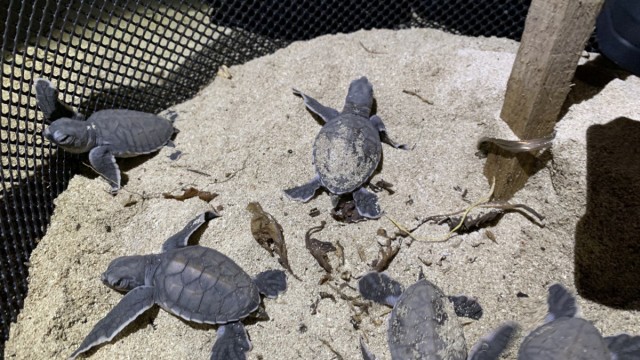Turtle cooling may not be for everyone, but it helps: To save the green sea turtle, animal rights activists in Australia regularly water the animals’ nests with water that they get from the sea with large watering cans. In this way they ensure that male turtles hatch from the eggs and they are essential for the survival of the species Chelonia mydas urgently needed in times of climate change.
The development of the sex of the green sea turtle depends on the temperature in the nest: if it is around 32 degrees Celsius, only females hatch. Male embryos develop at four degrees cooler, 28 degrees Celsius. This “temperature-dependent sex determination” is also known in lizards, crocodiles and some fish. Biologists don’t know exactly why they exist. Presumably it is simply an additional mechanism in addition to the genetic determination of gender that nature has devised.
In the case of the green sea turtle, climate change and the associated warming has disrupted this method, which previously reliably produced a balanced ratio between females and males: on some beaches, for example in the north of the Great Barrier Reef, there are now almost no hatches only females.
After hatching, all baby turtles run into the sea as if on command.
(Photo: Gerard Lacz via www.imago-images/imago images/Gerard Lacz)
“As the sex ratio moves toward 100 percent female, it becomes more difficult for adult female turtles to find male partners for mating,” says Arthur Barraza of Australia’s Griffith University in a press release in the science journal Frontiers in Marine Science.
There, Barraza has just published research showing that climate change is not the only human-caused disturbance upsetting the sex ratio of the green sea turtle, threatening the species’ survival. “Ocean pollution from human activities also affects the sex ratio of developing sea turtles by increasing the existing surplus of females,” says Barraza.
To find out, the researchers collected 17 complete clutches on Heron Island, a small sandy islet in the south of the Great Barrier Reef, and buried them again at an experimental site where the temperature in the nest was measured hourly. Heron Island is a well-known breeding site for green sea turtles; every year between 200 and 1,800 females come there to lay their eggs in the sand and let them hatch in the sun. After two to three months, the hatched young dig themselves out of the sand and run as quickly as they can into the sea.

The temperature, which influences the sex ratio, was measured every hour in the test nests.
(Photo: Arthur Barraza/Arthur Barraza)
However, the turtle offspring from the collected clutches did not get that far. The scientists caught them as soon as they hatched and put them to sleep so that they could be examined. You cannot tell the gender of young sea turtles from the outside. To do this, the researchers had to remove and examine the animals’ sexual organs.
In order to analyze the little turtles’ exposure to environmental chemicals, they also removed the animals’ livers and examined them for various substances, including the metals chromium, antimony, barium and cadmium, but also organic compounds such as polycyclic aromatic hydrogen compounds.
According to the results, more females hatched in eleven of the clutches collected than would have been expected based on the temperature conditions alone. According to the study, the reason for this is chemical substances that the researchers found in the livers of the turtle offspring. The connection was clearest with the metals antimony and cadmium: the higher the concentration of these substances in the animals’ livers, the greater the deviation towards female animals.
How can that be? The study authors assume that both substances are similar to estrogens, i.e. female sex hormones, and therefore dock onto estrogen receptors and thus trigger the same processes as the sex hormones. Cadmium in particular has long been known to have a negative effect on the reproductive ability of sea creatures; for example, it reduces the quality of the sperm in some fish. Antimony is created, among other things, when plastic bottles are broken down in the sea.

